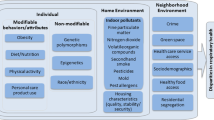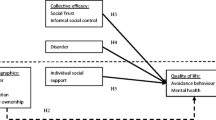Abstract
OBJECTIVE: We explore differences in the prevalence of asthma and other respiratory diseases at the neighborhood level. In addition to traditional metrics of neighborhood structure (e.g., concentrated disadvantage, residential stability), we incorporate residents’ evaluations of neighborhood context. We examine the extent to which indicators such as disorder (observable signs of physical and social decay) and collective efficacy (trust and shared expectations for beneficial community action) account for differences in the prevalence of asthma and other respiratory diseases.
METHODS: We examine 338 Chicago neighborhoods, combining 3 data sources from the 1990s: 1) the Metropolitan Chicago Information Center Metro Survey; 2) the Decennial Census; and 3) the Project on Human Development in Chicago Neighborhoods Community Survey. We use a multilevel statistical approach to disentangle neighborhood- from individual-level effects.
MEASUREMENTS: A survey-based response to whether a physician has diagnosed asthma, bronchitis, emphysema, or other breathing problems.
RESULTS: Findings indicate that individual- and neighborhood-level factors are associated with asthma/breathing problems. At the individual level, female gender, smoking, and a weight problem are positively associated with asthma/breathing problems, while Latino ethnicity is protective. At the neighborhood level, collective efficacy is protective against asthma/breathing problems. Residential stability is positively associated only when levels of collective efficacy are controlled.
CONCLUSIONS: Neighborhood context, particularly collective efficacy, may be an underlying factor that reduces vulnerability to asthma and other respiratory diseases. Collective efficacy may enhance the ability to garner health-relevant resources, eliminate environmental hazards that trigger asthma, and promote communication among residents which, in turn, enables dissemination of information relevant to respiratory ailments.
Similar content being viewed by others
References
Steigman DM. Is it “urban” or is it “asthma”? Lancet. 1996;348:143–4.
Weiss KB, Grant EN, Li T. The effects of asthma experience and social demographic characteristics on responses to the Chicago Community Asthma Survey-32. Chicago Asthma Surveillance Initiative Project Team. Chest. 1999;116(4 suppl 1):183S-89S.
National Center for Health Statistics. New estimates for asthma tracked. Atlanta, Ga: Centers for Disease Control; 2001.
Carr W, Zeitel L, Weiss K. Variations in asthma hospitalizations and deaths in New York City. Am J Public Health. 1992;82:59–65.
National Institute of Allergy and Infectious Diseases. Asthma: a concern for minority populations. Bethesda, Md: National Institutes of Health; 2001.
Weiss KB, Wagener DK. Geographic variations in US asthma mortality: small-area analyses of excess mortality, 1981–85. Am J Epidemiol. 1990;132(1 suppl):S107-S15.
Finkelstein JA, Fuhlbrigge A, Lozano P, et al. Parent-reported environmental exposures and environmental control measures for children with asthma. Arch Pediatr Adolesc Med. 2002;156:258–64.
Mansour ME, Lanphear BP, DeWitt TG. Barriers to asthma care in urban children: parent perspectives. Pediatrics. 2000;106:512–9.
Adams RJ, Fuhlbrigge A, Guilbert T, Lozano P, Martinez F. Inadequate use of asthma medication in the United States: results of the asthma in America national population survey. J Allergy Clin Immunol. 2002;110:58–64.
Hartert TV, Windom HH, Peelbes RS Jr, Freidhoff LR, Togias A. Inadequate outpatient medical therapy for patients with asthma admitted to two urban hospitals. Am J Med. 1996;100:386–94.
Schwartz J, Gold D, Dockery DW, Weiss ST, Speizer FE. Predictors of asthma and persistent wheeze in a national sample of children in the United States. Association with social class, perinatal events, and race. Am Rev Respir Dis. 1990;142:555–62.
Almeida JP, Lwebuga-Mukasa JS. Geographic variations in asthma mortality in Erie and Niagara counties, western New York, 1991–96. Am J Public Health. 2001;91:1394–5.
Naureckas ET, Wolf RL, Trubitt MJ, et al. The Chicago Asthma Consortium: a community coalition targeting reductions in asthma morbidity. Chest. 1999;116(4 suppl 1):190S-93S.
Sampson RJ, Raudenbush SW, Earls F. Neighborhoods and violent crime: a multilevel study of collective efficacy. Science. 1997;227:918–23.
Browning CR, Cagney KA. Neighborhood structural disadvantage, collective efficacy, and self-rated physical health in an urban setting. J Health Soc Behav. 2002;43(December):383–99.
Patrick DL, Erickson P. Health Status and Health Policy: Allocating Resources to Health Care. New York, NY: Oxford University Press; 1993.
Earls F. Connecting Social Science to the World. Cambridge, Mass: Harvard University; 2001. Available at: http://www.hms.harvard.edu/chase/projects/chicago/about/connect.html. Accessed January 22, 2004.
Raudenbush SW, Bryk AS. Hierarchical Linear Models Applications and Data Analysis Methods. Thousand Oaks, Calif: Sage; 2002.
Eisner MD, Yelin EH, Trupin L, Blanc PD. Asthma and smoking status in a population-based study of California adults. Public Health Rep. 2001;116:148–57.
Litonjua AA, Sparrow D, Celedon JC, DeMolles D, Weiss ST. Association of body mass index with the development of methacholine airway hyperresponsiveness in men: the Normative Aging Study. Thorax. 2002;57:581–5.
Guerra S, Sherrill DL, Bobadilla A, Martinez FD, Barbee RA. The relation of body mass index to asthma, chronic bronchitis, and emphysema. Chest. 2002;122:1256–63.
Chen Y, Dales R, Tang M, Krewski D. Obesity may increase the incidence of asthma in women but not in men: longitudinal observations from the Canadian National Population Health Surveys. Am J Epidemiol. 2002;155:191–7.
Homa DM, Mannino DM, Lara M. Asthma mortality in U.S. Hispanics of Mexican, Puerto Rican, and Cuban heritage, 1990–95. Am J Respir Crit Care Med. 2000;161:504–9.
Palloni A, Morenoff JD. Interpreting the paradoxical in the Hispanic paradox: demographic and epidemiologic approaches. Ann NY Acad Sci. 2001;954:140–74.
Wilson WJ. The Truly Disadvantaged: The Inner City, the Underclass, and Public Policy. Chicago, Ill: The University of Chicago Press; 1987.
Litonjua AA, Carey VJ, Burge HA, Weiss ST, Gold DR. Exposure to cockroach allergen in the home is associated with incident doctordiagnosed asthma and recurrent wheezing. J Allergy Clin Immunol. 2001;107:41–7.
Klinenberg E. Heat Wave: A Social Autopsy of Disaster in Chicago. Chicago, Ill: The University of Chicago Press; 2002.
Tartasky D. Asthma in the inner city: a growing public health problem. Holist Nurs Pract. 1999;14:37–46.
Williams DR. Socioeconomic differentials in health: a review and redirection. Social Psychol Q. 1990;53:81–99.
Author information
Authors and Affiliations
Corresponding author
Rights and permissions
About this article
Cite this article
Cagney, K.A., Browning, C.R. Exploring neighborhood-level variation in asthma and other respiratory diseases. J GEN INTERN MED 19, 229–236 (2004). https://doi.org/10.1111/j.1525-1497.2004.30359.x
Issue Date:
DOI: https://doi.org/10.1111/j.1525-1497.2004.30359.x




